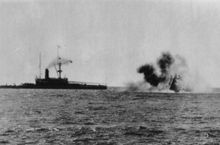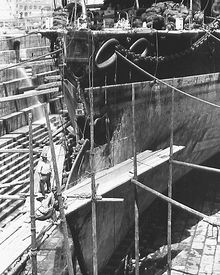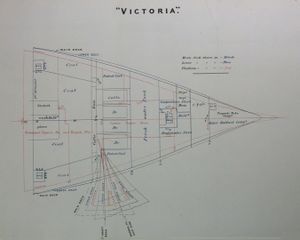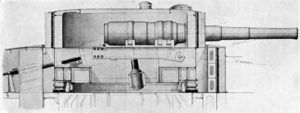إتشإمإس ڤكتوريا (1887)
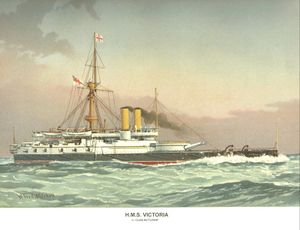 HMS Victoria by William Frederick Mitchell
| |
| التاريخ | |
|---|---|
| الاسم: | HMS Victoria |
| الباني: | Armstrong Whitworth Elswick yard |
| الثمن: | £845,000 |
| رقم الحوض: | 490 |
| وُضِع هيكلها: | 13 June 1885 |
| أُطلِقت: | 9 April 1887 |
| بدأت الخدمة: | March 1890 |
| الكنية: |
list error: <br /> list (help) "The Slipper";[1] Victoria and her sister ship Sans Pareil together were known as "The Pair of Slippers"[2] |
| المصير: | Accidentally rammed and sunk, 22 June 1893 |
| السمات العامة [3] | |
| الفئة والنوع: | Victoria-class battleship |
| الازاحة: | 11،020 long ton (11،200 t) |
| الطول: | 340 ft (100 m) |
| العارضة: | 70 ft (21 m) |
| الغاطس: | 26 ft 9 in (8.15 m) |
| قدرة التركيب: |
list error: <br /> list (help) 8،000 ihp (6،000 kW) (natural draught) 14،482 ihp (10،799 kW) (forced draught) |
| الدفع: |
list error: <br /> list (help) 2 × Humphreys & Tennant triple-expansion engines 2 × screws |
| السرعة: |
list error: <br /> list (help) 16 kn (18 mph; 30 km/h) (natural draught) 17.3 kn (19.9 mph; 32.0 km/h) (forced draught) |
| المرافقون: | 430; as flagship: 583 |
| التسليح: |
list error: <br /> list (help) 2 × BL 16.25 in (413 mm) guns 1 × BL 10 in (250 mm) gun 12 × BL 6 in (150 mm) guns 12 × 6-pounder guns 6 × 14 in (360 mm) torpedo tubes |
| الدروع: |
list error: mixed text and list (help)
|
| Service record | |
|---|---|
| جزء من | Mediterranean Fleet |
| القادة | Captain Maurice Bourke |
HMS Victoria was the lead ship in her class of two battleships of the Royal Navy. On 22 June 1893, she collided with Camperdown near Tripoli, Lebanon during manoeuvres and quickly sank, taking 358 crew with her, including the commander of the British Mediterranean Fleet, Vice-Admiral Sir George Tryon. One of the survivors was executive officer of the Victoria, John Jellicoe, later commander-in-chief of the British Grand Fleet at the Battle of Jutland.
Grounding
On 29 January 1892, Victoria ran aground at Snipe Point near Platea on the Greek coast. Platea had been selected as a convenient friendly port for British ships to use as a base for exercises with torpedoes and mines and each ship of the Mediterranean Fleet would go there in turn during the winter. Torpedoes would be launched from fast moving ships in real battle conditions, but it was desirable to practice this in relatively shallow waters so that the torpedoes could be recovered afterwards (they were supposed to float once their motors stopped but sometimes sank). Captain Bourke had appreciated the potential difficulties of operating his ship in shallow waters, and had ordered a crew to set out a buoy offshore where the water shoaled to 60 ft (18 m). The crew missed the shallowest point, so that Victoria ran aground at 9 kn (10 mph; 17 km/h) onto the rocky shoal and stuck fast. The fore end of the ship ended up 7 ft (2.1 m) higher out of the water than would be normal as momentum drove it up onto the shoal. The ship's bottom was damaged, and three compartments flooded. The stern, however, was still in 66 ft (20 m) of water. Admiral Tryon was notified and departed for the scene in Surprise, also ordering a dockyard tug Sampson with pumping equipment and hawsers. Hecla — a torpedo-depot ship — was already at Platea and made two attempts to tow Victoria free. These failed, but she assisted with laying anchors to hold the rear of the ship steady until further help could arrive. Phaeton, Edinburgh, Dreadnought, Scout and Humber were also called to the scene.[4]
The collision
The British Mediterranean Fleet was one of the most powerful in the world at the time. The Royal Navy saw the Mediterranean as a vital sea route between Britain and India, under constant threat from the navies of France and Italy, and concentrated an impressive force in it. On 22 June 1893, the bulk of the fleet, 11 ironclads (eight battleships and three large cruisers), were on their annual summer exercises off Tripoli in Lebanon.
Tryon was a strict disciplinarian who believed that the best way of keeping his crews taut and efficient was by continuous fleet evolutions, which before the invention of wireless were signalled by flags, semaphore and signal lamp. He had gained a reputation as a daring and highly proficient handler of his ships. His speciality was a new system (the "TA" system) by which complex manoeuvres could be handled by only a few simple signals, but which required his ships' captains to use their initiative; a quality which had become blunted by decades of naval peace since Trafalgar, and which was unwelcome in a hierarchical navy which deified Admiral Horatio Nelson while misunderstanding what he had stood for. A taciturn and difficult man for his subordinate officers to deal with, Tryon deliberately avoided making his intentions known to them in advance, so as to train them to be adept in handling unpredictable situations.
Camperdown strikes Victoria
By the time that both captains had ordered the engines on their respective ships reversed, it was too late, and Camperdown's ram struck the starboard side of Victoria about 12 ft (3.7 m) below the waterline and penetrated 9 ft (2.7 m) into it. Reversing the engines only had the effect of causing the ram to be withdrawn to let in more seawater before all of the watertight doors on Victoria had been closed. Two minutes after the collision, the ships were separated again.
The weather was hot.
Victoria capsized just 13 minutes after the collision, rotating to starboard with a terrible crash as her boats and anything free fell to the side and as water entering the funnels caused explosions when it reached the boilers.
Admiralty technical report
وصلات خارجية
- Dive HMS Victoria in Lebanon
- Victoria memorial in Portsmouth
- Lebanon Daily Star article on the discovery of the wreck
- HMS Victoria on the wrecksite, including video and position
- Poem by William McGonagall commemorating the loss of the Victoria
References
- ^ Hough, pp. 47-48
- ^ Hough, p. 48
- ^ Chesneau, Koleśnik & Campbell 1979, p. 30.
- ^ Fitzgerald p.333-336
ببليوجرافيا
- Chesneau, Roger; Koleśnik, Eugène M.; Campbell, N.J.M. (1979). Conway's All the World's Fighting Ships, 1860–1905. London: Conway Maritime Press. ISBN 0-85177-133-5.
{{cite book}}: Invalid|ref=harv(help) - Bennett, Geoffrey (1968). Charlie B: A Biography of Admiral Lord Beresford of Metemmeh and Curraghmore. London: Peter Dawnay Ltd.
- Andrew Gordon, The Rules of the Game: Jutland and British Naval Command, John Murray.
- David Brown, Warrior to Dreadnought: Warship development 1860-1905, Chatham Publishing.
- Richard Hough, Admirals in Collision, Hamish Hamilton Ltd, London. Copyright 1959.
- Oscar Parkes British Battleships, ISBN 0-85052-604-3.
- Louis Decimus Rubin, The Summer the Archduke Died: Essays on Wars and Warriors, University of Missouri Press, [2008], ISBN 0-8262-1810-5
- Rear-Admiral C. C. Penrose Fitzgerald, Life of Vice-Admiral Sir George Tryon K.C.B., William Blackwood and sons, Edinburgh and London, 1897
- The Times, The Loss of HMS Victoria, 2 November 1893, page 4, issue 34098, column A. (Admiralty minutes describing the sinking)
- Minutes of Proceedings at a Court-Martial held on board her Majesty's ship Hibernia at Malta, on Monday, the seventeenth day of July 1893; and by adjournment, every day thereafter (Sunday excepted) to the Twenty-seventh day of July 1893, to enquire into the loss of her Majesty's ship Victoria , Her Majesty's Stationery Office, printed by Darling & son Ltd, 1893.
قالب:Victoria class battleship
- WPSHIPS:Infobox list errors
- Pages with empty portal template
- Mediterranean articles missing geocoordinate data
- All articles needing coordinates
- Tyne-built ships
- Armstrong Whitworth ships
- Victoria-class battleships
- Victorian-era battleships of the United Kingdom
- Shipwrecks in the Mediterranean
- Maritime incidents in 1893
- 1887 ships
- Ships sunk in collisions




